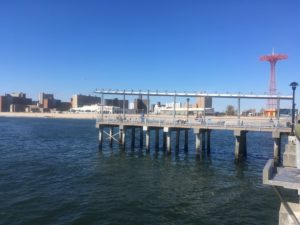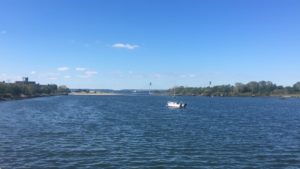Overgrown weeds rustle with the breeze on a pair of properties at the T-shaped intersection of Neptune Ave and West 21st Street on Coney Island. They get most of their attention these days from passersby who toss pizza boxes and plastic bottles over the fence.
Coney Island looks at this scene and sees a future ferry stop. New York City doesn’t seem to share the vision. In fact, Coney Island residents have long felt neglected by New York City, a sentiment they see as reflected in the state of these city-owned lots—and the ongoing battle for their restoration.
In the middle of the two properties, an abandoned pier juts into the murky Coney Island Creek. It’s hard to tell just how rundown that pier is, but it is clear that the city has long abandoned this place. In 2013, residents tried to prove to the city that these lots–and their neighborhood–deserves its attention. They are still making that argument.

The beach and boardwalk of Coney Island, known as the People’s Playground, attracts millions of visitors every year, making it one of the most sought-out tourist attractions in New York City. Despite its storied past and its place in the city’s current life, its residents have long felt unappreciated by city officials. As Daniel Ioannou, a local resident and activist, put it: “We’ve been a neighborhood that’s been abandoned.” He says the city sees the area as nothing more than an amusement park to serve tourists.
In fact, many citizens here point to the lack of transportation options–and the city’s continued refusal to improve them–as proof of city neglect. Alexandra Silversmith, the Executive Director of Alliance for Coney Island, a local nonprofit organization, points out that “Every beach neighborhood in Brooklyn has a ferry except for Coney Island.” The city’s most recent jab? The Rockaway Ferry, which residents watch pass them by every hour during its route from Manhattan to Rockaway Beach.
Locals say the New York City/Coney Island relationship wasn’t always this way. Before Superstorm Sandy hit in 2012, the city started advertising efforts to start a new ferry service. Coney Island residents were delighted. Although they had heard rumors in the past, Ioannou, who continues to advocate for ferry service, says 2012 felt different. “It was real this time,” he says, “because there were other neighborhoods involved.” In those days a local advocacy group called Friends of Coney Island Creek Ferry and Landing chartered a 150-passenger ferry to prove to the city that the creek was easily navigable. The experiment was a success, but after Sandy struck, the city had to shelve its plans to focus on reconstruction, which included plans to dam the creek to prevent future flooding.
Then, when the city announced it would move forward with a citywide ferry service early this year, Coney Island residents were dismayed to find that their neighborhood had been passed over.
According to the study behind the new ferry routes, Coney Island service would require too much investment and too little payoff. The creekside location was not part of the study, however. The city only assessed Steeplechase Pier, located in the oceanside amusement district, less than a mile from the creekside lots. The study found that the city would incur a whopping $19 million cost to outfit Steeplechase Pier with a bulwark to protect the ferry from rough seas. The study also cited low passenger interest as another reason for the neighborhood’s rejection. Residents say these figures, based on the 2013 study, are outdated and inaccurate. They are also frustrated that the city continues to consider the Steeplechase pier–and not the creek.
Ioannou is among them. He has created a petition to advocate for a new feasibility study—based around a creekside location and using what he considers proper metrics to determine ridership potential.
The city’s study, he points out, used a five-dollar one-way fare, nearly double what commuters spend to use the subway. The city predicted that the higher fare would deter residents from using a sea route. But using this metric, ferry advocates say, is unfair. The city, argues Silversmith, “subsidized service for other areas,” meaning that commuters pay the same rate as the current subway fare. The ferry’s website confirms that one-way passengers can board for the same price as the subway. A 30-day pass also costs the same as the monthly subway ticket. Ioannou feels the city owes Coney Island another study, one that uses the subsidized rate, to properly measure ridership potential.
Ioannou also wants a new study to survey a creekside location as a potential ferry landing. The city’s study explains why only the Steeplechase pier was considered: “To be attractive to recreational users, the ferry landing should be located on the oceanside, to provide convenient service to the Coney Island amenities and attractions.” According to the report, a creekside location, about half a mile from the beach and boardwalk, would be “too far from the amusement district.” This has outraged residents, who feel it proves the city doesn’t pay them as much respect as other beach neighborhoods. Ioannou sent his own report back to the economic development corporation to argue with the city’s reasoning.

In his report, targets inconsistencies in the city’s study: “The NYCEDC is unable to claim three blocks is too distant as they allowed the current Rockaway ferry landing to be the same distance from their beaches and boardwalk.” This argument holds: as passengers on the Rockaway ferry disembark, they are whisked into free shuttles, which then transport them to their destination along the beach. In fact, each shuttle route stretches approximately three miles, much farther than Coney Island’s potential half-mile ride. Ioannou, along with the 1,600-plus supporters who have signed his petition, question why a similar system wasn’t considered for Coney Island.
Ioannou chose an online petition, he says, because he wanted residents to be able to post their comments and tell the city in their own words how much they need better transportation options. One commenter, Bruce Brodinsky, asks, “How can the city bypass the biggest entertainment area along the ferry route?” Dean Andrews, another supporter of the petition, agrees: “Coney Island is grossly underserved by public transit.”
Mayor Bill de Blasio, in a recent letter to Coney Island Councilman Mark Treyger, states that Coney Island may be reconsidered for ferry service–in 2018, after careful review of the routes currently in service. Ioannou is frustrated that the future of his neighborhood likely depends on the success of another. As he looks through the chain-link fence at that unused pier, he says he wonders why the concerns of Coney Island have fallen on deaf ears.


Leave a Reply